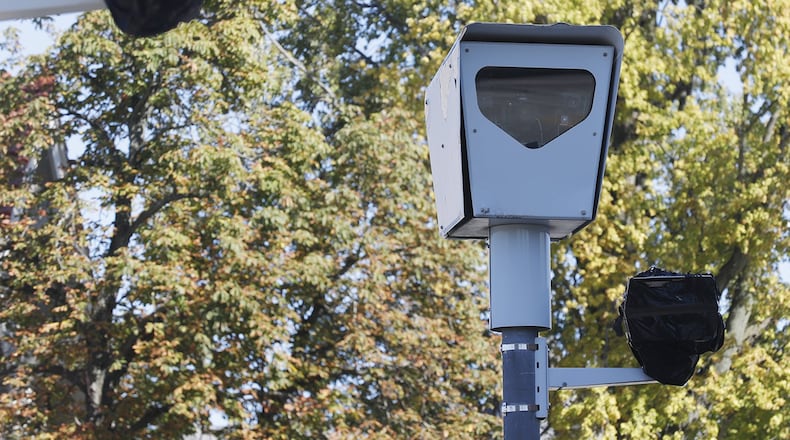RELATED: Judge rules against Springfield in red light camera case
“We’ve had no conversation at all that I’ve been a part of,” Copeland said. “We’re not ready to move on that at all. I assume we need to make a decision some time but we haven’t talked about that yet.”
Springfield has 17 cameras at 10 intersections that were turned off in 2015 once a new state law went into effect requiring a police officer to be present at the time of the violation. Those regulations have led to multiple lawsuits from cities across Ohio, including one filed by the city of Springfield, that alleged the new rules violate local home-rule authority.
The program has been suspended until city commissioners have a complete understanding of the updated law, Springfield Law Director Jerry Strozdas said.
“It’s kind of unfair to our citizens to be caught in this back-and-forth battle between the cities and the state,” he said. “(The city) is taking a timeout until we can get a ruling about what the rules are.”
RELATED: Springfield considers lifting ban on beekeepers in city
Springfield had used red light cameras for nearly a decade — the city issued about 77,000 citations between 2006 and 2015, collecting about $3.4 million in fines — when it shut them off because of the new law. Under the state law, officials in Springfield estimated they would have had to hire at least 42 new officers to run its program.
Earlier this year, the Ohio Supreme Court declared a law restricting red light cameras unconstitutional, impacting 8 million drivers statewide.
The court ruled that the state law restricting the use of speed and red light cameras hampered cities’ home-rule authority, which allows municipalities to pass laws to govern themselves. The city of Dayton filed the case and Springfield’s appeal was included in that case, said Edward Miller, the supreme court’s public information director.
Dayton challenged three parts of the state’s law. That included language that a police officer be posted at each operating camera, that cities conduct a three-year traffic study before deploying a camera and, that speeders be given leeway of 6 miles per hour over the limit in a school zone and 10 miles over elsewhere.
Springfield’s arguments against the law were rejected by a Clark County judge in 2015 and the city later lost an appeal. The city then appealed to the Ohio Supreme Court. That case was put on hold pending the outcome of the Dayton lawsuit.
MORE CITY NEWS: Medical marijuana ban ends in Springfield, area to get 2 dispensaries
City leaders believes the entire law should be struck down, Strozdas said, not just certain portions of it.
“We’re arguing it’s all unconstitutional and they can’t make us do any of these things,” Strozdas said.
Strozdas is surprised the Supreme Court hasn’t done anything with Springfield’s case after its ruling on the Dayton lawsuit, he said. It’s possible the court could move forward or decide not to hear Springfield’s case at all, Strozdas said.
SOCIAL MEDIA: FOLLOW REPORTER MICHAEL COOPER ON FACEBOOK AND TWITTER.
In 2007, Springfield intersections with red light cameras saw 90 accidents. That number decreased to 44 in 2014 — a 51 percent decrease. A year later, the cameras were turned off due to the rule changes.
Overall traffic crashes increased 8 percent between 2014 and 2016 and traffic crashes at monitored intersections increased 13 percent from 44 in 2014 to 50 in 2016, according to the Springfield Police Division.
The program was effective while it was operational, Copeland said.
“The evidence is clear that the way we applied it was both clear and did reduce accidents,” Copeland said. “It’s something we have to look at seriously, but I haven’t really thought about it much at this point.”
Staying with the story
The Springfield News-Sun has provided extensive coverage of red light cameras since Springfield’s program began more than a decade ago, including stories digging into the money generated by them, effect on crashes and lawsuits filed challenging new restrictions on their use.
Red light camera crashes
Here’s a look at the number of crashes at the 10 intersections with red light cameras during Springfield’s program:
2007: 90 crashes
2008: 56 crashes
2009: 75 crashes
2010: 52 crashes
2011: 56 crashes
2012: 48 crashes
2013: 46 crashes
2014: 44 crashes
Source: City of Springfield
By the numbers
77,000: Red light camera citations issued by the city since the program started
51 percent: Reduction in crashes at intersections with cameras after the devices were installed
$3.4 million: Fines from red light cameras collected since Springfield installed them between 2006 and 2015.
Source: City of Springfield
About the Author

